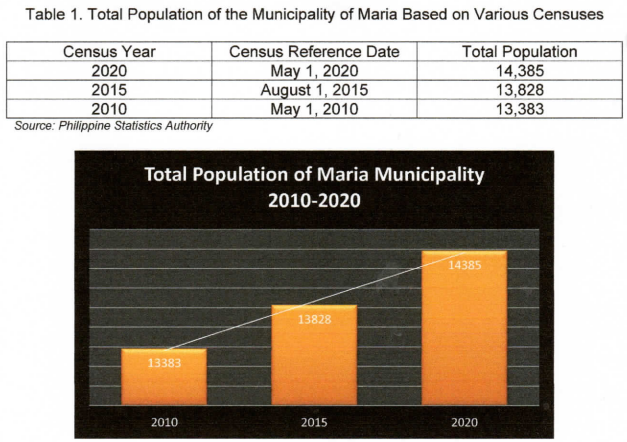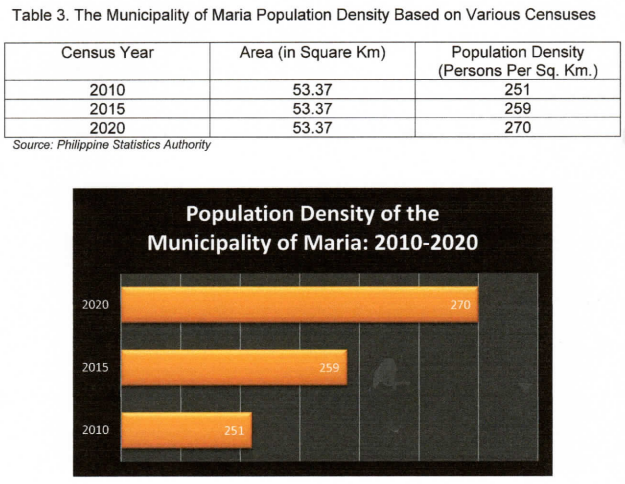Highlights of the Population of the Municipality of Maria in Siquijor Province, 2020 Census of Population and Housing (2020 CPH)
As of 01 May 2020, the population of the municipality of Maria, including Filipinos in Philippine embassies, consulates and missions abroad is 14,385 persons based on the 2020 Census of Population and Housing (2020 CPH).
The population for 2020 has increased by 557 persons from the population of 13,828 in 2015. It is also more than 1,002 persons compared with the population of 13,383 in the 2010 Census of Population and Housing. (Table 1)

From 2015 to 2020, the population of the municipality of Maria has increased by 0.83% annually. While from 2010-2015, the population growth rate (PGR) was 0.62%. (Table 2)

With a total land area of approximately 53.37 square kilometers, the population density of the municipality of Maria in 2020 was posted at 270 persons per square kilometer. This represents an increase of 11 persons per square kilometer from the population density of 259 persons per square kilometer in 2015. In 2010, there were 251 persons residing in every square kilometer of land. (Table 3)

The municipality of Maria ranked 5th among the six municipalities in Siquijor province with 14,385 persons. It is composed of 22 barangays.
Out of the 22 barangays in this municipality, Barangay Liloan was the most populous in 2020 with 1,459 persons followed by Barangays Poblacion Norte and Nabutay at 1,153 persons and 1,000 persons respectively. Table 4.

In 2020, Barangay Pisong B was the least populous barangay with 248 persons, followed by Barangays Pisong A and Cabal-asan with 366 persons and 389 persons respectively. Table 5.

Technical Notes
The 2020 Census of Population and Housing (CPH) was undertaken by the Philippine Statistics Authority in September 2020 as mandated by Republic Act No. 10625, otherwise known as the Philippine Statistical Act of 2013. It was the 15th census of population and 7th census of housing that was undertaken since the first census in 1903. The 2020 CPH was designed primarily to take an inventory of the total population and housing units all over the Philippines and collect information about the demographic, social, economic and cultural characteristics and facilities of the housing units. The reference period for the 2020 CPH was 01 May 2020 (12:01 a.m.). The enumeration was delayed and conducted in September 2020 due to the pandemic problem caused by Covid-19.
Definition of Terms
Census of Population and Housing refers to the complete process of collecting, compiling, evaluating, analyzing, publishing and disseminating data about the population and housing units in the country.
Total Population is composed of household population plus the institutional population.
Population Growth Rate is an annual average rate of change of population size during a specified period.
Population Density is a measurement of the number of people in an area. It is calculated by dividing the number of persons by the area and is usually shown as the number of persons per square kilometer.
(SDG.) AURELIA M. CANDA
Chief Statistical Specialist

